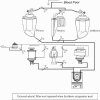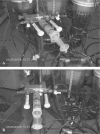Preventing gaseous microemboli during blood sampling and drug administration: an in vitro investigation
- PMID: 17972455
- PMCID: PMC4680731
Preventing gaseous microemboli during blood sampling and drug administration: an in vitro investigation
Abstract
The detection and prevention of gaseous microemboli (GMEs) during cardiopulmonary bypass has generated considerable interest within the cardiac surgical community. There have been several landmark papers that have used transcranial Doppler devices during cardiopulmonary bypass to detect gaseous microemboli activity in the patients' middle cerebral artery during perfusionist interventions. To determine if this source of emboli could be prevented, a shunt was developed between the oxygenator's sampling manifold and the oxygenator's venous line. This shunt bypassed the venous line and emptied into the oxygenator's integral cardiotomy. An in vitro experiment was performed using three open system oxygenators (Sorin Synthesis, Sorin PrimeOx2, and Terumo Capiox SX25) to compare post-arterial filter emboli detection using the Hatteland CMD20 Microbubble Detector under tightly controlled conditions. After injection of air through the sampling manifold, the PrimeOx2 and the Synthesis oxygenators had statistically significant fewer GMEs with the shunt used than when the shunt was not used. Using a shunt in the sampling manifold during perfusionist interventions will dramatically reduce or eliminate gaseous microemboli transmission to the patient during bypass with both the PrimeOx2 and Synthesis oxygenators. However, results indicate that further study of GME handling with all oxygenator's integral cardiotomies is warranted.
Conflict of interest statement
The author has stated that he has no material, financial or other relationship with any healthcare-related business or other entity whose products or services are discussed in this paper. This study was conducted at a Sorin Group research facility with the assistance of Sorin Group employees.
Figures






References
-
- Taylor RL, Borger MA, Weisel RD, et al. . Cerebral microemboli during cardiopulmonary bypass: Increased emboli during perfusionist intervention. Ann Thorac Surg. 1999;68:89–93. - PubMed
-
- Nijhoff M.. Microembolization: Etiology and prevention. In: Hilberman M, ed. Brain Injury and Protection During Heart Surgery. Martinus-Nijhoff Publishing, Boston, MA; 1998; 67–83.
-
- Pugsley W.. The use of Doppler ultrasound in the assessment of microemboli during cardiac surgery. Perfusion. 1989;4:115–22.
-
- Clark RE, Brillman J, Davis DA, et al. . Microemboli during coronary artery bypass grafting: Genesis and effect on outcome. J Thorac Cardiovasc Surg. 1995;109:249–58. - PubMed
-
- Stock UA, Miller T, Bienek R, et al. . Deairing of the venous drainage in standard extracorporeal circulation results in a profound reduction of arterial micro bubbles. Thorac Cardiovasc Surg. 2006;54:39–41. - PubMed
MeSH terms
LinkOut - more resources
Full Text Sources
